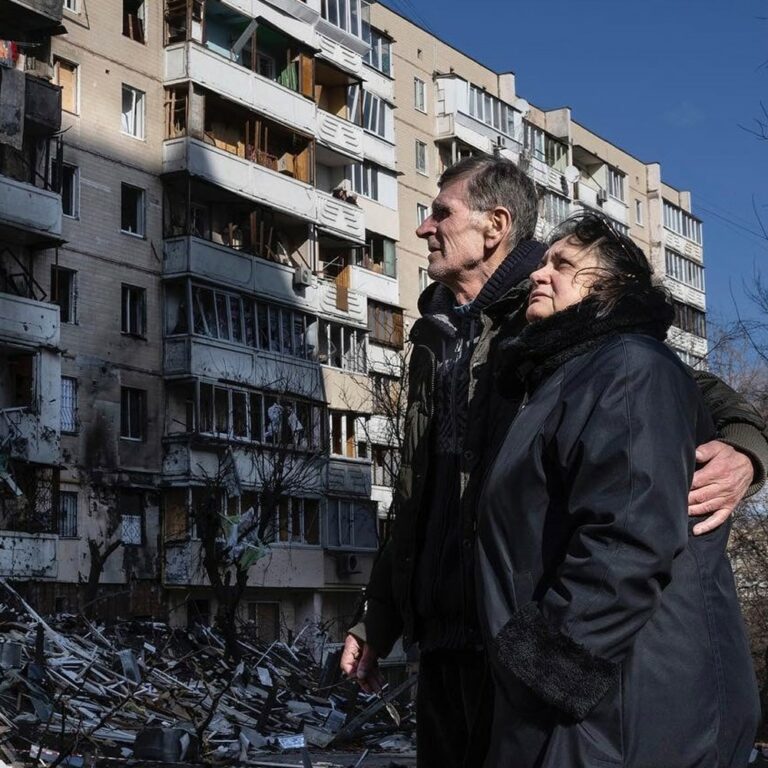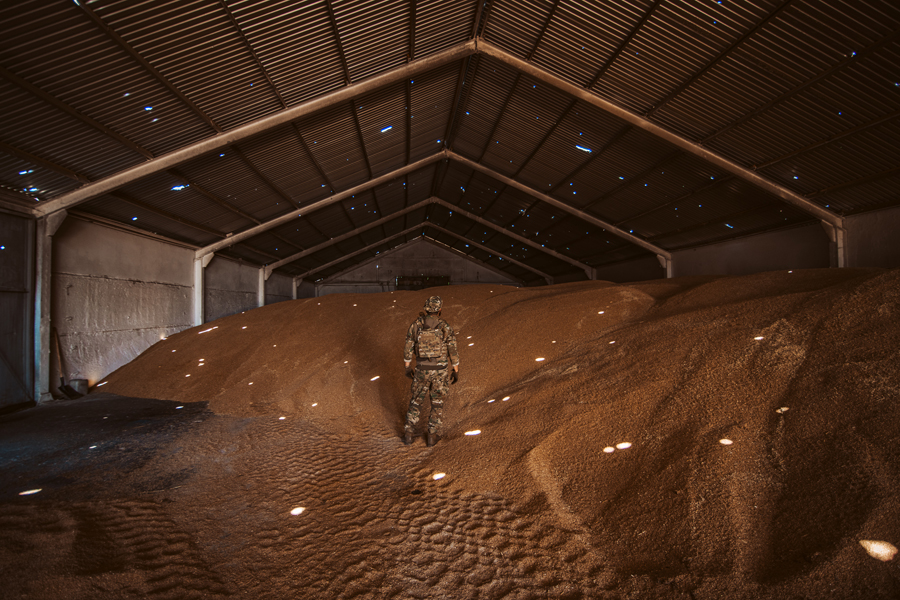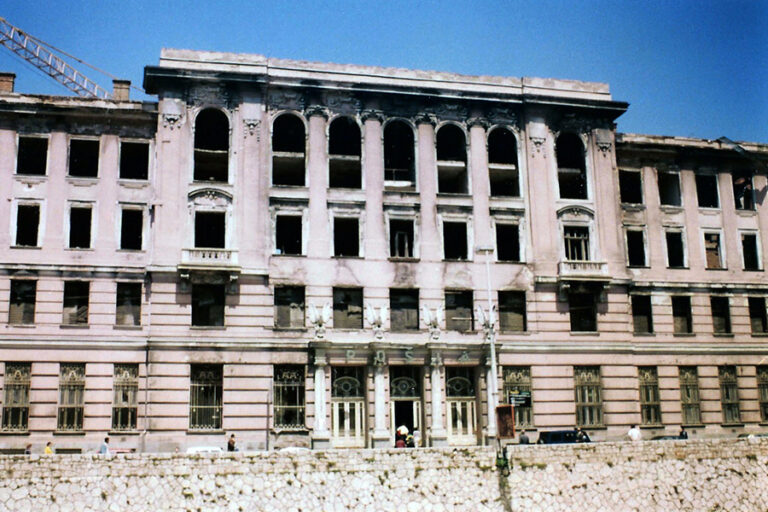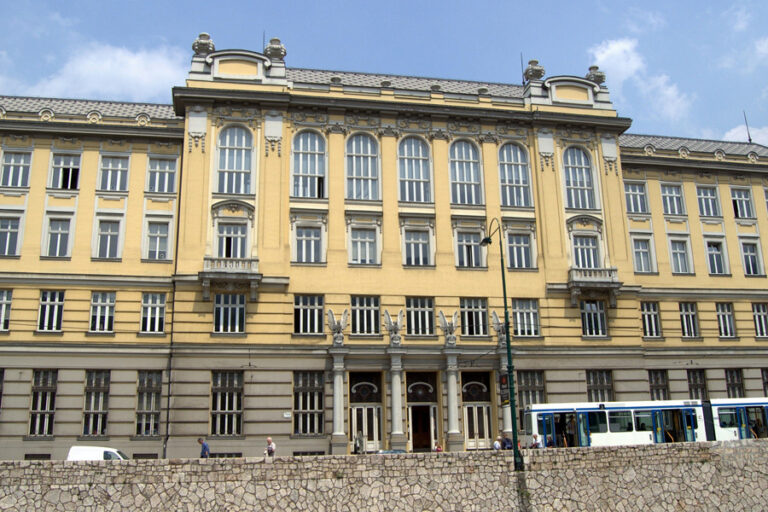
Online-maps that capture destruction, manuals for rebuilding cities, military rehabilitation programs, and agreements with partner states to restore infrastructure — Ukraine is poised to become even better than before a full-scale invasion. Ukrainians are already working on this, without putting it off to, “let’s do it after victory”.
In this material, we talk about the various opportunities and challenges of the post-war reconstruction of Ukraine and consider the recovery experiences of other countries that survived war.
Documenting the consequences of war
For more than half a year, the Russian army has been destroying military and civilian infrastructure every day. As of August 22, 2022, experts estimated the direct damage from the destruction of more than 110 billion dollars (~2.9 trillion UAH). And already in September, the Ministry of Environmental Protection and Natural Resources of Ukraine announced about 1 trillion hryvnias in environmental damage. The total losses of Ukraine related to the destruction of infrastructure and the loss of economic potential are up to 4 billion dollars per day.
According to the Kyiv School of Economics data, about 860,000 families have lost their homes since the start of the full-scale invasion. More than 40 million m² of housing stock was destroyed or damaged, dozens of medical institutions and educational institutions, shopping centers and oil depots,and thousands of meters of roads and railways were also affected. In addition to direct damage, there are also collateral losses associated with destruction: a decrease in GDP, an outflow of investments and labor, a decrease in the country’s tourist attractiveness, etc.

Various Ukrainian and foreign initiatives record the damage caused by the occupiers with the help of specially developed online maps. Therefore, the whole world sees the daily crimes of the Russian occupiers, so this time Russia will not be able to get away with phrases like “we haven’t been here”.
A number of initiatives make it possible to immediately record the damage caused. For example, to document the destruction in Ukraine,
the platform “Russia will pay” was created. Here you can report the damage, attach photo or video evidence of the damage. Information about damaged property can also be submitted using the “Diia” digital application. In the future, such initiatives can help bring criminals to justice and obtain compensation.

Help from the whole world
With the beginning of the full-scale invasion, a number of countries around the world (such as Canada, the USA, Australia, Great Britain, etc.) froze the foreign assets of Russian banks, oligarchs and businesses that support and/or finance the activities of the Kremlin regime. The total amount is about 1 trillion dollars, of which about 300 billion dollars are the assets of the Central Bank of Russia. The amounts will be increased in the future, in particular due to sales of Russia’s sanctioned foreign property. These funds are planned to be used for the restoration of Ukraine.
In social networks, Ukrainians periodically discuss the prospects of post-war reconstruction of settlements. Observations of such posts show that in society, in addition to the determination to restore the infrastructure of cities and villages, there is a clear desire to make it even better than it was before the great war. However, there are also many concerns. For example, after the end of hostilities, Ukraine will be left without financial support, and therefore will not be able to start a full recovery. But this fear is gradually dissipating, because even in the first months of the full-scale invasion, the governments of a number of countries announced their plans to join the reconstruction of Ukraine, providing funds or the support of specialists.
In the fifth month since the beginning of the great war, the Estonian government announced its possible participation in the reconstruction of 15 objects of civil infrastructure in Zhytomyr and nearby settlements. In particular, the construction of a destroyed kindergarten in the city of Ovruch has begun.
Negotiations are ongoing regarding Denmark’s participation in the reconstruction of the city of Mykolaiv and nearby settlements: it is about the restoration of specific objects and the provision of construction equipment.

On June 17, at the British-Ukrainian summit in London, a memorandum was signed on the readiness of Great Britain to participate in the reconstruction of Kyiv. And on August 25, the transport ministers of both countries signed a joint action plan for rebuilding the transport network of Ukraine. It provides financial and expert assistance in the restoration of railways, ports and airports. In addition, Great Britain will hand over to Ukraine several buses and equipment for the repair of routes of strategic importance for grain export. The total amount of support will be almost 4 billion pounds sterling (about 170 billion UAH). Also, the governments of Poland, the Czech Republic, Italy, Greece, Japan and other countries have expressed their desire to help with the restoration of certain cities.

At the same time, on June 15, the President of Ukraine signed a decree on the creation of the National Council for the Recovery of Ukraine from the Consequences of the War. Teams of Ukrainian architects are also not standing aside. For example, AIMMenergy architectural office launched an online platform for finding solutions for restoring destroyed buildings. Options for construction and reconstruction of buildings using the latest energy efficiency and eco-building technologies are published here, as well as materials about various post-war reconstruction projects of Ukraine are collected.
Some Ukrainian organizations are already working on proposals for the reconstruction of individual buildings. For example, the loft biuro company offered several options for restoring the Mykolaiv Regional State Administration, which was destroyed by Russian troops at the end of March 2022. A special working group was also created, which, together with the Architectural Chamber of the National Union of Architects of Ukraine (NSAU), will develop new housing construction standards, taking into account the experience of the Great War. At the same time, urban planners create guidebooks on reconstruction of the cities.

All of this proves that “let’s do it after victory” is not a Ukrainian scenario. Ukrainians are doing everything they can right now. In particular, a number of state and volunteer initiatives have repaired or are continuing the restoration and construction of buildings damaged by the occupiers. These include modular houses that will become a temporary shelter for those who lost their homes due to the full-scale war.
Why is Europe’s postwar experience important to Ukraine?
Some states, such as Poland, Germany and the Netherlands, experienced post-traumatic growth after the wars, when they managed not only to overcome existing difficulties, but also to surpass pre-war indicators of the quality of life. Their experience of post-war development can help Ukraine restore its infrastructure faster and return to normal life.

It is important to emphasize that the experience of post-war reconstruction in European countries was not always successful. However, it is the analysis of past mistakes that will help Ukrainians to avoid their own, taking into account all possible risks. For example, in Bosnia and Herzegovina, after the end of the Bosnian War (1992–1995), there was no significant economic growth, despite financial and various resource assistance from other countries that sought to help the country integrate into Europe in the future.
They say that among the mistakes of that time were the lack of a general development strategy, lack of a single center for coordinating reconstruction programs, duplication of efforts of various organizations, inappropriate use of funds, low management potential of authorities, etc.
Bosnian War
The war in Bosnia and Herzegovina is an international military conflict on the territory of Bosnia and Herzegovina. It lasted between Serbia and Montenegro on the one hand, the Republic of Bosnia and Herzegovina — on the second, and Croatia — on the third.Monitoring and controlling of financial flows aimed at industrial development is important for a country rebuilding after the war. This helps to avoid the concentration of funds in the hands of one corporation or firm that will only care about its own profits. Something similar happened in Italy after the end of the Second World War. At that time, a significant share of financial assets were taken over by representatives of big business and individual clans, which slowed down the country’s economic development.
Ukraine will need to resolve a number of social issues, including financial compensation for the victims. This once again emphasizes the importance of timely documentation and assessment of the damage caused by the enemy. Of course, it will not be possible to do without financial assistance from other countries. So far, one can only guess whether it will be a new “Marshall Plan”, soft loans or compensations of the aggressor country. As for the latter, Ukraine will have a long way to go. The options can be different: from Russia’s voluntary agreement to pay reparations (full or partial compensation by the aggressor country for the damages it caused to another country or countries by starting the war. — ed.) to forced recovery of the frozen assets of the aggressor country through international lawsuits. It should be taken into account that reimbursement processes can last for years. In particular, in cases of compensation due to the foreign assets of Russia and Belarus, each of the countries that will own such resources will have to work out their own legislative scheme to make these payments to Ukraine.
The Marshall Plan
US program for economic assistance to European countries after World War II. It was implemented from April 1948 to June 1952.
Also, the country’s general recovery and development strategy must meet the tasks necessary for EU accession, because on June 23, 2022, Ukraine finally received this desired candidate status. And a number of programs and strategies related to the post-war reconstruction of Ukraine should be coordinated by a single center, the activity of which, in turn, should be monitored by involving international partners and experts.
Thus, at the International Conference on the Restoration of Ukraine, which took place on July 4-5, 2022 in the Swiss city of Lugano, one of the points of discussion was the creation of the State Development Bank of Ukraine. The idea is not new and can be implemented following the example of similar institutions that operated in European countries after the end of the Second World War. The main purpose of such a bank is to control financial receipts by creating obstacles to misuse funds. Also, the bank can play an important role in the recovery of the country’s economy thanks to lending to projects of strategic importance, the level of risk of which will be high for ordinary banks or investors. Such a key role was played by the KfW bank in West Germany after the Second World War. KfW continues to be one of the most successful state-owned banks.
KfW Bank
The State Bank of the Government of the Federal Republic of Germany, which is a credit institution for reconstruction: supports small and medium-sized businesses, finances social infrastructure, engages in export and project financing, refinancing, etc.
Raise the economy and industry
The Great War dealt a significant blow to the economy of Ukraine. In just the third month of the full-scale invasion, total losses reached $100 billion, equal to 50% of the total GDP of 2021.
A successful solution for the recovery of the country will be the integration of the Ukrainian economy into the EU economic system. Various European logistics and infrastructure projects can help in this. For example, the inclusion of Ukrainian logistics routes (road, rail, air and water) in the European logistics networks under the TEN-T program (in July 2022, the European Commission included Ukrainian logistics routes in the indicative maps of the project), reconstruction of existing and opening of new checkpoints on the borders with European countries, the transition of the railway to the standard track of the European format, etc. (a standard track with a width of 1435 mm is widespread in the world, while the Ukrainian railway currently has several such sections, primarily in the border areas, and the rest of the railway track has tracks with a width of 1520 mm. — ed.). While hostilities continue, Ukraine and EU countries are negotiating the liberalization of cargo transit from Ukraine to Europe, the creation of “Solidarity Routes” for the export of grain and the import of necessary goods, support for Ukrainian exports of goods through European ports, etc. All these developments will remain relevant even after the end of the war.
TEN-T
Trans-European transport networks are an infrastructure project of the European Union, which aims to create an end-to-end connection of European countries with a network of roads, railways, airports and waterways.
The Russian army is aiming fire at Ukrainian enterprises of various profiles and capacities. Fortunately, many businesses managed to evacuate equipment and/or raw materials or finished goods while continuing to operate. However, some were partially or completely forced to stop work: Ilyich Iron and Steel Works and Azovstal Iron and Steel Works in Mariupol, Antonov Aircraft Plant in Kyiv, Kremenchuk Oil Refinery, Zoria — Mashproekt Gas Turbine Research and Production Complex in Mykolaiv, and others.

Photos by Anton Sheveliov
Currently, it is very difficult to estimate the exact damages from the destruction of these enterprises, but this will have consequences not only for Ukraine, but also for the world. For example, “Azovstal” plant, which became an outpost of the Mariupol defense at the beginning of the full-scale invasion, annually produced millions of tons of cast iron, steel and rolled metal (some of its types were produced only here). The plant provided more than 12,000 jobs for Mariupol residents. The last time “Azovstal” was completely stopped was in 1941 due to the war against Nazi Germany and resumed work in 1943. In April 2022, the Russian army bombed and practically destroyed the plant.

Also, as a result of Russian aggression, the state-owned enterprise “Artemsil” in the city of Soledar in Donechchyna stopped working. After that, there was a shortage of salt in Ukraine for some time, because it is the largest salt-producing enterprise in the country, which worked for both the domestic and foreign markets.
In the context of the recovery of production, it is worth considering the example of Korea. After the end of the Korean War (1950–1953), the country was divided into the Southern and Northern parts. The industry in North Korea was more developed even before the war, but after the end of hostilities, the southern part had to invest in the development of science and technology due to increased reorientation to exports. Thanks to the financial protection of the USA, South Korea has successfully recovered, but this development did not take place at a fast pace.
Korean War
Armed conflict between the Democratic People's Republic of Korea and the Republic of Korea.It seems that after the end of the Second World War, Japan developed. In this case, the USA took over the defeated country: they fought local oligarchs and tried to develop a free market. Full-fledged development of the country was preceded by many reforms in the land, tax and labor spheres.

Localization of production can become an important condition for full-fledged post-war development for Ukraine — at least 60% of products must be produced within the country. This point, by the way, is specified in the plan for the recovery of Ukraine after the war, which was approved by the specialized committee of the Verkhovna Rada in May 2022. The plan is designed for 10 years and aims to strengthen European integration and support private initiatives.
Reconstruction as a chance for improvement
Not only residential buildings, but also cultural and religious buildings, which are architectural monuments, monuments of the nature reserve fund, etc., are under fire by the Russian army. However, reconstruction can be a good chance for Ukraine to move away from ineffective or morally outdated practices of both Soviet and modern planning of public space, taking into account the historical legacy and the modern context: real needs of people, landscape features, environmental friendliness and aesthetics.

Dozens of examples are known when settlements destroyed as a result of the war became better than before it. This is vividly illustrated by restored cities with a rich architectural heritage — Warsaw (Poland), Munich (Germany); reconstructions with redevelopment, where historical architecture is harmoniously combined with modern – London (Great Britain), Cologne (Germany); “revival” of industrial cities with a small amount of historical and architectural heritage, when emphasis was placed on the reconstruction of pre-war production capacities — Dortmund (Germany).
Taking into account the failures and risks of other countries will help Ukraine better cope with the challenges of reconstruction both during and after a great war. An example of the not very successful recovery of Sarajevo — the capital of Bosnia and Herzegovina — after the Bosnian War of 1992-1995 can be indicative. The authorities made a mistake by not creating a single platform to coordinate organizations that helped the city. Despite significant investments – donor conferences organized by the World Bank in cooperation with the EU from 1996 to 2002 raised about 5.1 billion dollars for projects – the reconstruction of Sarajevo was, in fact, limited to cosmetic repairs. Although only 850,000 dollars were spent on the restoration of the National and University Library in Sarajevo, which is a symbol of the city and the entire country. Because of these mistakes, the city now consists of a number of quaint districts, in some places with dense high-rise buildings. Typical problems of modern Sarajevo are overpopulation, traffic jams and environmental problems.


slideshow
It is important for urban planners (especially foreign ones) who will be involved in planning the reconstruction of Ukrainian settlements to take into account the specifics of life in Ukrainian towns and villages. Because it varies so much, the same solutions may not work for each community. Therefore, it is very important to understand how and with what a particular settlement lives, and for this it is necessary to establish cooperation with the community.
In some places, it is worth rethinking the essence and expediency of rebuilding specific destroyed or damaged buildings: Ukraine has a lot of outdated Soviet heritage, such as bridges, factories, hotel and health complexes, etc. Their maintenance is expensive and sometimes impractical. It is also worth mentioning the practice of the Soviet Union was to build cities around an industrial facility, but this had the reverse side of the coin to consider: after the decline of a factory or plant, the place became deserted (for example, Orbita,
Tsukrovariv, Stepnohirsk, Teplodar, etc.). Now Ukrainians can move away from such a paradigm.
Following the examples of European cities, instead of rebuilding the former resort from the ruins, it is possible to invest in the development of high-speed rail connections in the region. Thus, passengers will be able to quickly move to the desired distances, and if necessary, conveniently reach the airport in the nearest big city. The experiences of European countries with developed railway connections, such as Austria, Germany, Italy or France, are illustrative here. Airports in these countries are often located far from large cities and are connected to them by rail. This is how “Beauvais” (Paris), “Memmingen” (Munich), “Cologne-Bonn”, “Leipzig-Halle”, etc. international airports are arranged. At the same time, the presence of a network of high-speed train routes allows passengers to use alternative travel options.

However, perhaps the biggest challenge for Ukraine is unfriendly neighboring countries (Russia and Belarus), which can behave unpredictably. They will have to be bordered in the future, so the presence of a sufficient number of bomb shelters, strengthening of building structures, creation of natural obstacles such as hills, canals, rivers, and strategic planning of the placement of military and warehouse facilities will remain relevant for a long time. Not only the appearance and comfort of settlements, but also the safety of Ukrainians depends on the quality of these solutions. In particular, in July 2022, the government approved a law on the necessity of arranging shelters during the design and construction of new buildings.

Return own citizens
The reconstruction of the country is not only the restoration of physical objects. Already now, Ukraine needs qualified and experienced workers, and after the victory, this issue will become even more urgent. Therefore, the government must do everything to ensure that Ukrainians can live with dignity in their country, and not abroad.
According to various data, the number of Ukrainians in EU countries is approximately 5.5–7 million people. About 3 million were working or studying abroad even earlier, before the full-scale war. According to a survey by the sociological group “Rating”, 90% of Ukrainian citizens do not plan to move abroad for permanent residence. However, only half of the surveyed Ukrainians see a future for their children in their native country, if the danger will continue, — the survey of the Kyiv International Institute of Sociology shows.

Since April 2022, the number of those returning to Ukraine is greater than those leaving it. Among the reasons: the desire to return to the family, the feeling that the region of residence has become safer, etc. Some return because they do not have permanent housing and work abroad. And some still remain in other countries. Sociologists call different figures: from 5% to 10% of the total number of those who left. These people will probably remain abroad in the future.
The Ukrainian government is considering options for encouraging citizens to return to the Motherland: negotiations are underway with EU countries on the possibility of providing refugees with financial support for a certain period after returning to Ukraine. They are also discussing the provision of additional funding to hire Ukrainians for jobs that will help rebuild the state, as well as the creation of temporary basic income programs for those who will return home. In particular, some of these aspects are already foreseen in the project of the Recovery Plan of Ukraine.

Rehabilitation of those who remained in the country requires special attention: psychological adaptation and involvement of veterans in peaceful social life, rehabilitation of people with disabilities acquired during the war or post-traumatic syndrome, assistance to internally displaced persons, etc.
After the start of the Russian war in 2014, Ukraine already has some experience in military rehabilitation. Now there are a number of organizations that provide legal, social and psychological assistance to military personnel and their families, engage in medical rehabilitation and professional retraining of military personnel, and assist in obtaining education and reintegration into society. These are, in particular, the programs of the charity organization of the Ukrainian Greek-Catholic Church “Caritas of Ukraine”, the NGO “Pobratymy”, the Charitable Fund “International Association for the Support of Ukraine” (MAPU), the competent aid fund of the army “Come Back Alive” and others.
A number of medical rehabilitation facilities and mental health centers help the military for free or at discounted rates with government support. Treatment and rehabilitation programs are available to military personnel and abroad. Ukrainian soldiers have already used this opportunity in Lithuania and the Netherlands. Similar programs and rehabilitation centers may soon appear in Norway and Germany — negotiations began in the fourth month of the full-scale war.

There are also various psychological assistance and counseling programs for civilian residents. They are available both in different regions of Ukraine and abroad. Many of them are free or provide services for a nominal fee. Psychological centers and shelters for internally displaced persons, persons with disabilities, the LGBTQ(IA+) community, etc. are emerging.
LGBTQ(IA+)
Abbreviation from English words lesbian, gay, bisexual, transgender, queer, intersex, asexual, etc.The reconstruction of Ukraine’s infrastructure and the return of its citizens to a normal life is a long, difficult, but quite possible process. Ukrainians are already united and have strong support from the world community. Exploring the existing experiences of the post-war reconstruction of European countries will help to more meaningfully undertake the development of the country. It is important that this process began already — during the course of the Russian-Ukrainian war. And it will continue after the victory of Ukraine, because Ukrainians are determined to build their state, overcoming all threats.

